Ambastaia sidthimunki
Dwarf Chain Loach
SynonymsTop ↑
Botia sidthimunki Klausewitz, 1959; Yasuhikotakia sidthimunki (Klausewitz, 1959)
Etymology
Ambastaia: Named for Ambastai, a river considered to correspond to the Mekong in Ptolemy’s (ca. 90–168) Geographikê Hyphêgêsis (Handbook of Geography).
sidthimunki: unconfirmed, but possibly named in honour of Aree Sidthimunk, an ex-researcher at the Department of Fisheries, Ministry of Agriculture, Thailand.
Classification
Order: Cypriniformes Family: Botiidae
Distribution
Type locality is given as ‘brooks of northern Thailand’ or ‘Loom district, Yom River’, the latter of which probably corresponds to the Yom river in northern Thailand, an upper tributary within the Chao Phraya river system.
Roberts (1995) stated that A. sidthimunki occurs in the Xe Pian river, a tributary of the Xe Khong (which itself drains into the Mekong river main channel) in Champasak and Attapeu provinces, southern Laos, while Rainboth (1996) considered it to occur in the Cambodian section of the Mekong basin.
In reality all of the above are erroneous and refer to A. nigrolineata, with no mention of the Yom River in the original description of A. sidthimunki, which was based solely on aquarium specimens imported into Germany from ‘north Thailand’.
Instead, A. sidthimunki appears to be restricted to the Mae Klong river basin in western Thailand and the Ataran (Kasat in Thai) drainage, around the border between Thailand and Myanmar (K. Udomritthiruj, pers. comm.). Though potentially endangered it is still found in both systems, but Thai localities are kept secret for conservation purposes.
Thanks to Kamphol Udomritthiruj.
Habitat
Images we have seen from the Ataran basin depict relatively slow-flowing sections of forested, seemingly well-oxygenated headwaters with clear water, a mixed sand and rock substrate plus lots of submerged driftwood and leaf litter.
Other species known to inhabit the Ataran include Botia kubotai, Schistura vinciguerrae, S. robertsi, Garra sp. ‘redtail’ and Mastacembelus armatus, plus unidentified members of Devario, Scaphiodonichthys, Tor, Neolissochilus, Garra, and Schistura.
Maximum Standard Length
50 – 60 mm.
Aquarium SizeTop ↑
For long-term maintenance an aquarium with base measurements of 80 ∗ 30 cm or equivalent should be the smallest considered.
Maintenance
All botiids require a well-structured set-up although choice of décor is more-or-less down to personal taste, with A. sidthimunki one of the few representatives suitable for the fully-planted aquarium due to its diminutive size and tendency to swim above from the substrate.
A natural-style arrangement could include a substrate of sand or fine gravel alongside smooth, water-worn rocks and pebbles, driftwood roots and branches. Lighting can be relatively subdued, and plants able to grow in such conditions such as Microsorum, Taxiphyllum, or Anubias spp. can be added. These have an added benefit as they may be attached to pieces of décor in such a way as to provide useful shade.
Be sure to provide plenty of cover as Ambastaia spp. are inquisitive and seems to enjoy exploring their surroundings. Rocks, wood, flower pots and aquarium ornaments can be used in whichever combination to achieve the desired effect, and this may also help reduce aggressive behaviour (see ‘Behaviour and Compatibility’).
Bear in mind that these fishes like to squeeze themselves into small gaps and crevices, meaning items with sharp edges should be omitted, and any gaps or holes small enough for a fish to become trapped should be filled in with aquarium-grade silicone sealant. A tightly-fitting cover is also essential.
Although botiid loaches do not require turbulent conditions they prefer well-oxygenated water with some flow, are intolerant to accumulation of organic wastes, and requires spotless water in order to thrive.
For these reasons they should never be introduced to biologically immature set-ups, and adapt most readily to stable, mature aquaria. In terms of maintenance, weekly water changes of 30-50% tank volume should be considered routine.
Water Conditions
Temperature: 20 – 30 °C
pH: 5.5 – 7.5, though pH at localities sampled in the original description was measured to be 8.0.
Hardness: 18 – 215 ppm
Diet
Although Ambastaia spp. appear to be chiefly carnivorous they will also eat vegetative matter if available, often including soft-leaved aquatic plants.
They are largely unfussy feeders but should be offered a varied diet comprising quality dried products, live or frozen chironomid larvae (bloodworm), Tubifex, Daphnia, Artemia, etc., plus fresh fruit and vegetables such as cucumber, melon, blanched spinach, or courgette.
Home-made foods using a mixture of natural ingredients and bound with gelatin are also highly recommended.
Chopped earthworm can provide a useful source of protein but should be used sparingly, and although most botiid loaches prey on aquatic snails to an extent they are not obligate molluscivores and should never be considered as ‘pest control’.
Once settled into an aquarium they are bold feeders and often rise into midwater at meal times.
Behaviour and CompatibilityTop ↑
This species is generally considered to be an excellent choice for the community aquarium, but caution should possibly be exercised since conflicting observations exist. While some aquarists consider it to be peaceful over the long-term others report the opposite, with sedentary or long-finned fishes most at risk.
Typical injuries supposedly involve missing eyes or chunks of finnage, but it is unclear why this occurs in some cases and not others, and genuine proof remains lacking. It is therefore difficult to make recommendations; at the least we suggest that this species is unsuitable for smaller aquaria and should be maintained in as large a group as possible (see below).
Ambastaia spp. are gregarious and appear to form complex social hierarchies. They should be maintained in groups of at least 5 or 6 specimens, preferably 10 or more. When kept singly they can become withdrawn or aggressive towards similarly-shaped fishes, and if only a pair or trio are purchased the dominant individual may stress the other(s) to the extent that they stop feeding.
That said, they seemingly require regular contact with conspecifics, and this is exemplified by a number of behavioural rituals which have been recorded consistently in aquaria (see ‘Notes’).
Sexual Dimorphism
Sexually mature females are normally fuller-bodied and grow a little larger than males, while adult males develop slightly elongated snouts plus noticeably fleshy, thickened lips.
Reproduction
A. sidthimunki is farmed commercially for the aquarium hobby via the use of hormones but reports of breeding by private aquarists are more-or-less unheard of, possible because the majority are seasonal, migratory spawners in the wild.
While controlled breeding in the absence of chemical stimulation remains elusive, some instances of young fish appearing in established aquaria have occurred, with a particularly notable example being that of UK loach expert Mark Duffill who discovered a number of juveniles among his group of 36 adult specimens in 2007.
The fish were fed a varied diet as suggested above, pH was around neutral and the fish were housed in a 284 litre aquarium alongside groups of various small cyprinids and other loaches.
A full report from Mark documenting this success is available here.
NotesTop ↑
This species was unavailable to aquarists for several years prior to the turn of the century, and when commercially-produced stock first came onto the market prices were very high. Alternative vernacular names in English include ‘dwarf loach’, ‘dwarf botia’ and ‘chipmunk botia’, whereas many hobbyists tend to refer to it simply as ‘sid’.
It looks similar to its only congener A. nigrolineata, in which colour pattern consists of a solid dark lateral stripe and another running along the dorsal mid-line.
A. sidthimunki is diagnosed by possession two dorsal stripes anterior to the dorsal-fin and none behind, though in reality some specimens do have what could be described as a stripe posterior to the dorsal-fin which is usually broken by pale, saddle-like markings.
In adult A. sidthimunki there are numerous transverse, vertical bars connecting the two stripes and extending to the ventral surface; these may also be present in A. nigrolineata but are much less prominent and normally only extend the full distance between the stripes in the rear portion of the body.
The taxon Ambastaia was erected by Kottelat (2012) to accommodate these two species which are former members of the genera Botia and Yasuhikotakia.
Members are currently diagnosed from other botiids solely on the basis of adult colour pattern and its ontogeny, the former comprising a whitish-yellowish background with a black midlateral stripe on each flank and an additional, middorsal stripe, with vertical bars connecting these two stripes and extending onto the lower portion of the body.
The family Botiidae has been considered to represent a genetically distinct grouping since Nalbant (2002), having previously been considered a subfamily (Botiinae) of the family Cobitidae. The same author also moved some previous members of Botia into the new genus Yasuhikotakia based on a number of morphological characters.
Later Kottelat (2004) made further modifications to the taxonomy, raising Chromobotia for B. macracanthus and confirming that species previously included in the genus Hymenophysa should instead be referred to Syncrossus.
The former alteration was based on colour pattern plus some morphological characters and the latter because Hymenophysa not only represents a spelling mistake (McClelland’s original spelling was Hymenphysa) but is a junior synonym of Botia.
As a result of these works the family Botiidae is thus divided into two tribes within which Botia appears to be the most basal lineage:
Tribe Leptobotiini – Leptobotia, Parabotia, Sinibotia.
Tribe Botiini – Ambastaia, Botia, Chromobotia, Syncrossus, Yasuhikotakia.
Phylogenetic studies by Tang et al. (2005) and Šlechtová et al. (2006) have largely confirmed this system to be correct although the latter disagreed with the placement of Sinibotia, finding it to be more closely related to the tribe Botiini.
Ambastaia nigrolineata and A. sidthimunki were found to be more closely-related to both Sinibotia and Syncrossus than Yasuhikotakia, despite being considered members of the latter at the time. Šlechtová et al. also proposed the use of subfamily names under the following system:
Subfamily Leptobotiinae – Leptobotia, Parabotia.
Subfamily Botiinae – Botia, Chromobotia, Sinibotia, Syncrossus, Yasuhikotakia.
Within these, Botia appears to be the basal, i.e., most ancient, lineage and in a more-detailed phylogenetic analysis Šlechtová et al. (2007) confirmed the validity of the family Botiidae with the genera listed above as members rather then being grouped into subfamilies. This more recent, simpler system is the one we currently follow here on SF.
Some behavioural routines exhibited by Ambastaia spp. have been recorded often enough that they have been assigned non-scientific terms for ease of reference.
For example during dominance battles (these occur most frequently when the fish have been introduced to a new aquarium, or new individuals added to an existing group) the protagonists normally lose much of their body patterning and colouration, a phenomenon that has come to be known as ‘greying out’.
Such displays will sometimes also happen within an established group as individuals seek to improve social ranking but are usually nothing to worry about.
Interestingly some observations suggest that the character of the highest-ranked, or alpha, fish appears to affect that of the whole group though it must be said that scientific studies of botiid loach behaviour are virtually non-existent.
It certainly seems that they display a degree of ‘personality’ with some specimens being naturally bolder or more aggressive than others, for example. The alpha is normally the largest specimen within the group and often female.
‘Shadowing’ is an interesting behaviour in which younger individuals swim flank-to-flank with older, mimicking their every movement. Some keepers report that more than one smaller fish may shadow a larger simultaneously, with even three or four on each side!
The reason for it is unknown; it may relate to a group staying in touch with one another when rivers swell during times of flooding, perhaps reducing drag by swimming ‘in formation’ or having some other communicative function.
It has been observed in aquaria with both high and low water flow and seems to be habitual to the extent whereby some individuals will shadow other fishes if no conspecifics are present.
Sound also appears to be an important factor in communication since these loaches are able to produce audible clicking sounds, these increasing in volume when the fish are excited. The behavioural aspects of this phenomenon remain largely unstudied but the sounds are thought to be produced by grinding of the pharyngeal (throat) teeth or subocular spines.
A further curiosity is the so-called ‘loachy dance’ which involves an entire group swimming in a constant, restless fashion around the sides of the aquarium, usually utilising the full length and height.
The reasons for this are unknown and reports as to when it occurs vary but the most common triggers appear to be the addition of food, fresh water or new conspecifics, and it can last anything from a few minutes to a day or more.
Botiids also often settle at peculiar angles, wedged vertically or sideways between items of décor, or even lying flat on the substrate. This is no cause for alarm and appears to be a natural resting behaviour.
Ambastaia spp. also possess sharp, motile, sub-ocular spines which are normally concealed within a pouch of skin but erected when an individual is stressed, e.g., if removed from the water. Care is therefore necessary, since these can become entangled in aquarium nets and those of larger specimens can break human skin.
Botiids are also susceptible to a condition commonly referred to as ‘skinny disease’ and characterised by a loss of weight. This is especially common in newly-imported specimens and is thought to be caused by infestation of parasitic nematode roundworms. It is treatable using proprietary anthelmintic medications such as Flubendazole or Levamisole.
References
- Klausewitz, W., 1959 - Senckenbergiana Biologica 40(1/2): 51-53
Botia sidthimunki, eine neue Schmerle aus Thailand (Pisces, Cobitidae). - Arthainsee, A., T. Leamkom, A. Jutagate, and S. Chundum, 2010 - Journal of Agricultural Technology 6(4): 761-766
Genetic variation of five species of Yasuhikotakia in Thailand using AFLP. - Kottelat, M., 1998 - Ichthyological Exploration of Freshwaters 9(1): 1-128
Fishes of the Nam Theun and Xe Bangfai basins, Laos, with diagnoses of twenty-two new species (Teleostei: Cyprinidae, Balitoridae, Cobitidae, Coiidae and Odontobutidae). - Kottelat, M., 2001 - WHT Publications, Colombo: 1-198
Fishes of Laos. - Kottelat, M., 2004 - Zootaxa 401: 1-18
Botia kubotai, a new species of loach (Teleostei: Cobitidae) from the Ataran River basin (Myanmar), with comments on botiinae nomenclature and diagnosis of a new genus. - Kottelat, M., 2012 - Raffles Bulletin of Zoology Supplement 26: 1-199
Conspectus cobitidum: an inventory of the loaches of the world (Teleostei: Cypriniformes: Cobitoidei). - Kottelat, M. and X. Chu, 1987 - Zoological Research 8(4): 393-400
The botiine loaches (Osteichthyes: Cobitidae) of the Lancangjiang (Upper Mekong) with description of a new species. - Nalbant, T. T., 2002 - Travaux du Museum d'Histoire Naturelle 'Grigore Antipa' 44: 309-333
Sixty million years of evolution. Part one: family Botiidae (Pisces: Ostariophysi: Cobitoidea). - Nalbant, T. T., 2004 - Travaux du Museum d'Histoire Naturelle 'Grigore Antipa' 47: 269-277
Hymenphysa, Hymenophysa, Syncrossus, Chromobotia and other problems in the systematics of Botiidae. A reply to Maurice Kottelat. - Rainboth, W. J., 1996 - FAO, Rome: 1-265
Fishes of the Cambodian Mekong. FAO Species Identification Field Guide for Fishery Purposes. - Roberts, T. R., 1995 - Raffles Bulletin of Zoology 43(2): 463-467
Botia splendida, a new species of loach (Pisces: Cobitidae) from the Mekong Basin in Laos. - Taki, Y. and A. Doi, 1995 - Japanese Journal of Ichthyology 42(2): 147-155
Two new species of the cobitid genus [ì]Botia from the Lao Mekong Basin. - Tang, Q., B. Xiong, X. Yang, and H. Liu, 2005 - Hydrobiologia 544(1): 249-258
Phylogeny of the East Asian botiine loaches (Cypriniformes, Botiidae) inferred from mitochondrial cytochrome b gene sequences. - Tang, Q., H. Liu, R. Mayden, and B. Xiong, 2006 - Molecular Phylogenetics and Evolution 39(2): 347-357
Comparison of evolutionary rates in the mitochondrial DNA cytochrome b gene and control region and their implications for phylogeny of the Cobitoidea (Teleostei: Cypriniformes). - Šlechtová, V., J. Bohlen, and H. H. Tan, 2007 - Molecular Phylogenetics and Evolution 44(3): 1358-1365
Families of Cobitoidea (Teleostei; Cypriniformes) as revealed from nuclear genetic data and the position of the mysterious genera Barbucca, Psilorhynchus, Serpenticobitis and Vaillantella. - Šlechtová, V., J. Bohlen, J. Freyhof, and P. Ráb, 2006 - Molecular Phylogenetics and Evolution 39(2): 529-541
Molecular phylogeny of the Southeast Asian freshwater fish family Botiidae (Teleostei: Cobitoidea) and the origin of polyploidy in their evolution.
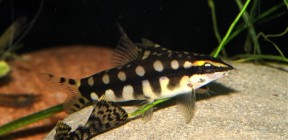
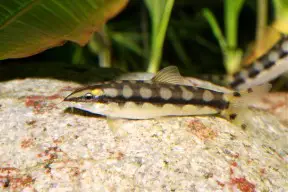





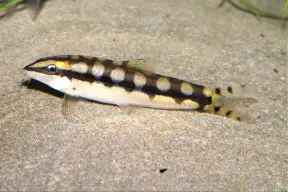
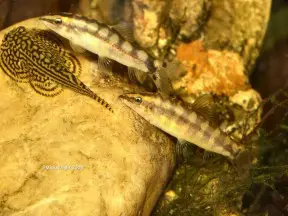
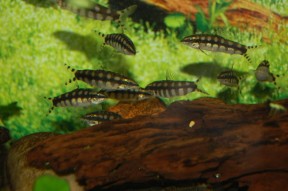

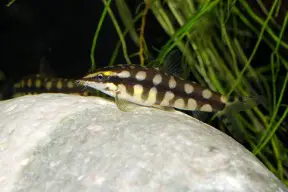
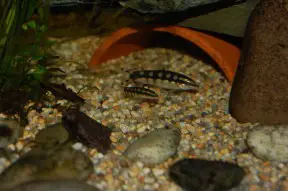

April 26th, 2015 at 7:46 am
“Botiids are also susceptible to a condition commonly referred to as ‘skinny disease’ and characterised by a loss of weight. This is especially common in newly-imported specimens and is thought to be caused by a species of the flagellate genus Spironucleus.
It’s treatable although the recommended medication varies depending on country. Hobbyists in the UK tend to use the antibiotic Levamisole and those in the United States Fenbendazole (aka Panacur).”
Matt, reexamine this text please.
Firstly, Levamisole is not an antibiotic, it is an Anthelmintic and a very narrow spectrum one, only effective against some nematodes. The fact that many use it attests to the major cause of “skinny disease” is nematodes and not flagellates…I thought this is well-known? … was there ever a single documented case of internal flagellates causing problems with botia? Further, very few use Fenbendazole (again, Anthelmintic but wide range), Flubendazole is the med of choice both in the UK and the US.